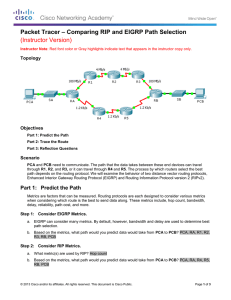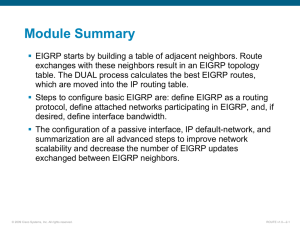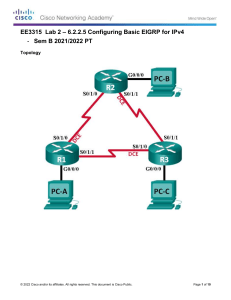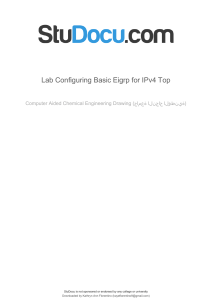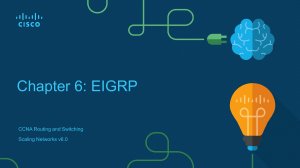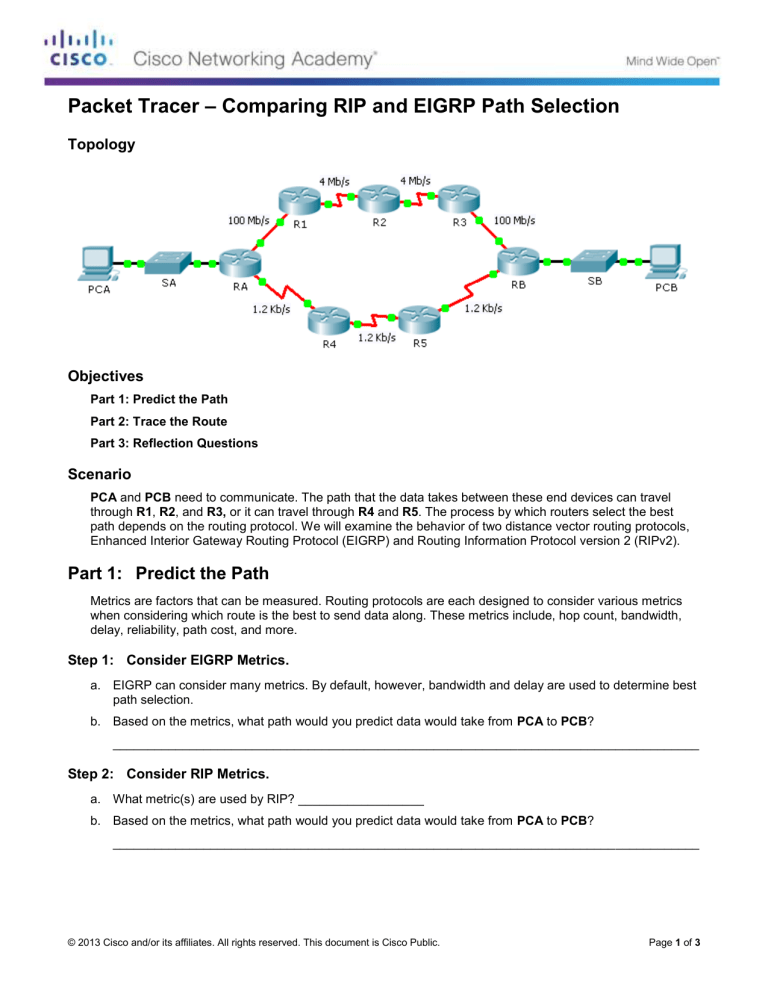
Packet Tracer – Comparing RIP and EIGRP Path Selection Topology Objectives Part 1: Predict the Path Part 2: Trace the Route Part 3: Reflection Questions Scenario PCA and PCB need to communicate. The path that the data takes between these end devices can travel through R1, R2, and R3, or it can travel through R4 and R5. The process by which routers select the best path depends on the routing protocol. We will examine the behavior of two distance vector routing protocols, Enhanced Interior Gateway Routing Protocol (EIGRP) and Routing Information Protocol version 2 (RIPv2). Part 1: Predict the Path Metrics are factors that can be measured. Routing protocols are each designed to consider various metrics when considering which route is the best to send data along. These metrics include, hop count, bandwidth, delay, reliability, path cost, and more. Step 1: Consider EIGRP Metrics. a. EIGRP can consider many metrics. By default, however, bandwidth and delay are used to determine best path selection. b. Based on the metrics, what path would you predict data would take from PCA to PCB? ____________________________________________________________________________________ Step 2: Consider RIP Metrics. a. What metric(s) are used by RIP? __________________ b. Based on the metrics, what path would you predict data would take from PCA to PCB? ____________________________________________________________________________________ © 2013 Cisco and/or its affiliates. All rights reserved. This document is Cisco Public. Page 1 of 3 Packet Tracer – Comparing RIP and EIGRP Path Selection Part 2: Trace the Route Step 1: Examine the EIGRP Path. a. On RA, view the routing table using the appropriate command. Which protocol codes are listed in the table and what protocols do they represent? ________________________________________________ b. Trace the route from PCA to PCB. What path does the data take? ___________________________________________________________ How many hops away is the destination? __________________ What is the minimum bandwidth on the path? __________________ Step 2: Examine the RIPv2 Path. You may have noticed that, while RIPv2 is configured, the routers ignore the routes that it generates, because they prefer EIGRP. Cisco routers use a scale called administrative distance and we need to change that number for RIPv2 in RA to make the router prefer the protocol. a. For reference purposes, show the routing table of RA using the appropriate command. What is the first number between the brackets in each EIGRP route entry? __________________ b. Set the administrative distance for RIPv2 using the following commands. This forces RA to choose RIP routes over EIGRP routes. RA(config)# router rip RA(config-router)# distance 89 c. Wait a minute and show the routing table again. Which protocol codes are listed in the table and what protocols do they represent? ____________________________________ d. Trace the route from PCA to PCB. What path does the data take? ___________________________________________________________ How many hops away is the destination? __________________ What is the minimum bandwidth on the path? __________________ e. What is the first number between the brackets in each RIP entry? __________________ Part 3: Reflection Questions 1. What metrics does the RIPv2 routing protocol ignore? ____________________________________________ How could this affect its performance? ________________________________________________________ 2. What metrics does the EIGRP routing protocol ignore? __________________ How could this affect its performance? _______________________________________________________________________________________ 3. Which do you prefer for your own Internet access, lower hops or more bandwidth? _____________________ 4. Is one routing protocol suitable for all applications? Why? _______________________________________________________________________________________ _______________________________________________________________________________________ _______________________________________________________________________________________ © 2013 Cisco and/or its affiliates. All rights reserved. This document is Cisco Public. Page 2 of 3 Packet Tracer – Comparing RIP and EIGRP Path Selection Suggested Scoring Rubric Activity Section Part 1: Predict the Path Question Location Possible Points Step 1-b 8 Step 2-a 8 Step 2-b 8 Part 1 Total Part 2: Trace the Route Part 3: Reflection Questions 24 Step 1-a 8 Step 1-b 8 Step 2-a 8 Step 2-c 8 Step 2-d 8 Step 2-e 8 Part 2 Total 48 1 7 2 7 3 7 4 7 Part 3 Total 28 Total Score 100 © 2013 Cisco and/or its affiliates. All rights reserved. This document is Cisco Public. Earned Points Page 3 of 3

